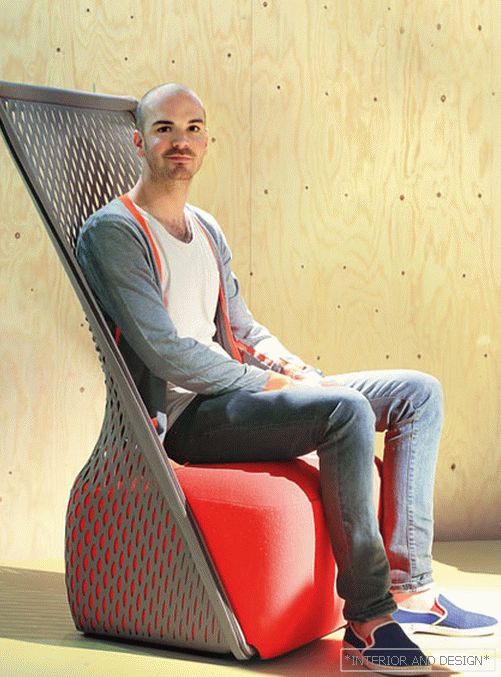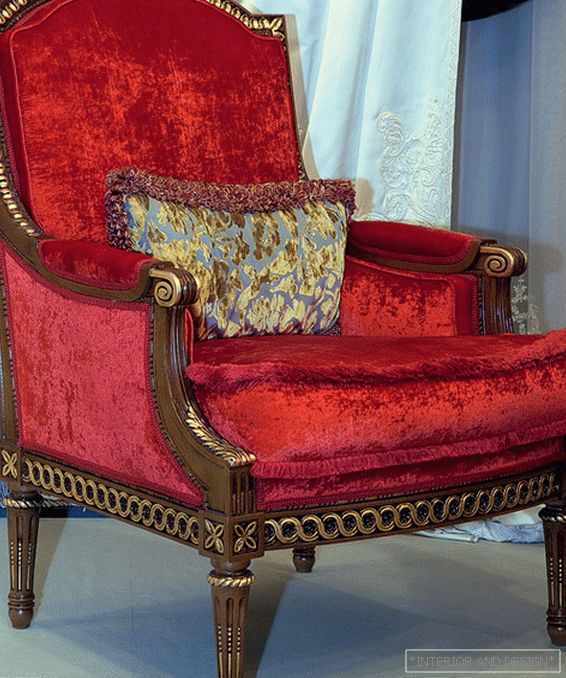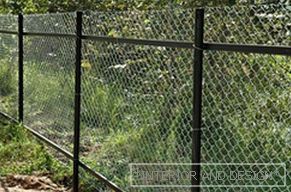 A popular material for fencing the backyard area, garden or just a plot is metal mesh. It is rather wear-resistant, practical, convenient and inexpensive material. Like other types of fences, mesh products are used to mark the perimeter of the territory, protect the site, the hedge frame and as a decor.
A popular material for fencing the backyard area, garden or just a plot is metal mesh. It is rather wear-resistant, practical, convenient and inexpensive material. Like other types of fences, mesh products are used to mark the perimeter of the territory, protect the site, the hedge frame and as a decor.
Content
- 1 Features mesh fencing
- 2 Pros and cons
- 3 Types of grids
- 4 Grid cost
- 5 Do-it-yourself grid installation
- 5.1 Required materials
- 5.2 Mesh Mounting
Features mesh fencing
When it is a question of a metal grid for fences, they mean either mesh netting, which is a structural material, made of wire by weaving, or welded mesh.
Grid из металла используется в качестве fencing:
-
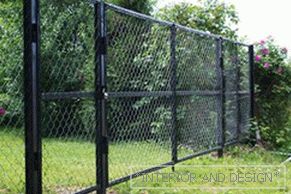 Plots of land;
Plots of land; - Yards, homesteads, gardens, gardens and parks;
- Construction and storage sites;
- Areas adjacent to residential and public buildings, hotels and offices;
- Kindergartens and nurseries;
- Educational institutions and sports grounds;
- Industrial, military and other facilities with special security requirements;
- To create cages and enclosures for dogs.
Advantages and disadvantages
The long experience of using metal mesh as a material for fences has allowed us to form a clear vision of the advantages and weak points of such fences.
pros fencing:
- Cheap (other types of fences are many times more expensive);
- Easily and quickly mounted, even independently;
- It is possible to fence very large areas;
- Possesses high strength;
- You can easily change the color;
- Service life can reach 50 years;
- Dismantling of the grid and its reuse is possible;
- Promotes free air circulation in the area;
- Does not create a shadow on the site;
- Allows you to admire the design of the house and the site;
- Fully performs protective function. It can be supplemented with barbed wire, a Bruno helix, or an electrical fence running along the upper edge;
- Byзволяет собакам эффективно обеспечивать охрану;
- It is a practical tool for zoning the site;
- Can be used as frame for a flower bed, trellis and hedge;
- It is simple and convenient for cleaning from dirt (washing with a stream of water with a big pressure).
Minuses:
- It is quite difficult to build a barrier above 3.5 m;
- Insecurity area from prying eyes is both a virtue and a disadvantage;
- For many, it is considered obsolete, not prestigious and the type of fencing that does not meet modern aesthetics.
Types of grids
Like other building materials, fencing nets have many varieties.
By production method and material:
-
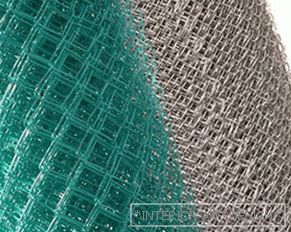 Rabbit. Refers to woven nets. The basis is steel wire round in cross section. It is divided by a number of signs:
Rabbit. Refers to woven nets. The basis is steel wire round in cross section. It is divided by a number of signs: - By cell shape - rhombic and square;
- By cell size in mm (number). Diamond-shaped have numbers from 5 to 20. Square - from 5 to 100;
- Standard and lightweight by weight. In a lightweight mesh, a thinner wire is used. For grids with numbers from 20 to 35, the wire 2 thickness is replaced by 1.8 mm and so on. With the largest cell of 100 mm, a diameter of 3 is used instead of 4 mm;
- Lightweight due to size. In addition to the smaller diameter of the wire, a decreasing grid cell is used first, decreasing in rows, and then again. The grid has less durability and is used as a temporary fence;
- Grid width (for the fence is the height of the fence) are made in increments of half a meter. For small rooms it is 1 m wide, for medium ones it is from 1 to 2 m, and the largest numbers are 2–4 m wide.
- Steel wire is simple, galvanized, covered with brass, stainless and coated. In the production of wire used steel with different carbon content. Rare non-ferrous metals are used for wire.
- woven. A special product in which various thin wires intertwine. The cell in this type is quite small. This type of mesh rarely used for fences.
- twisted. It is made by twisting wires that cross at an angle of 120 °, forming a hexagonal cell. Despite the large size of the cells (25−100 mm) and a large width (up to 3 m), this grid is almost never used for fences.
- Corrugated or fluted. This popular mesh has limited flexibility, as it is made from galvanized or black carbon steel and can be: corrugated, partly corrugated and intricate. Before the netting of the wire is bent. The wire has a diameter of 2 - 7 mm. This type of grid is always supplied in maps.
- Welded. This grid is made up of metal bars with diameters of 4−12 mm, which are connected at the intersection of spot welding. It is the most durable. As a rule, a large cell of 100–200 mm is made, of square or rectangular type, but sometimes it is given other shapes. Welding is performed on a galvanized bar or the entire mesh is zinc-plated after welding, which significantly increases durability. Now the welded mesh with high-quality polymer coating has become widespread. This option is very resistant to temperature changes (± 60 ° C) and any humidity.
-
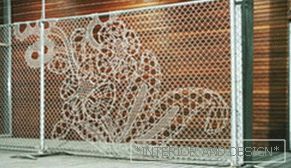 Decorative. Refers to welded meshes. Instead of a straight rod is used (corrugated, twisted
Decorative. Refers to welded meshes. Instead of a straight rod is used (corrugated, twisted etc. ), which creates a three-dimensional volume. Such a grid allows to imitate a forged grill to some extent, or simply to perform a decorative function. - Expanded metal This network is made of steel by pulling and notching without welded joints. The cells take the form of diamonds arranged in a staggered pattern. The stiffness and strength characteristics of the network are achieved as a result of changes in the dimensions of punching and sheet thickness.
- Plastic. Этот тип сетки постепенно начинает конкурировать с металлической сеткой. Byявляются всё более прочные пластиковые материалы. Byка этот вид сетки не может обеспечить в полной мере защитные функции и имеет срок службы порядка трёх-пяти лет.
- The mesh can be heat treated and untreated.
For sale packing
Vendors and manufacturers supply the grid in rolls and compact rolls of various widths and lengths (typically from 10 to 20 m), maps of different sizes, as well as in already made fence sections, wickets and gates. The framing sections are made from pipes, a corner or from these two assortments simultaneously.
By внешнему виду оград
There are several types of the upper edge of the fence: smooth edge, coal-like, wavy, semicircular
Grid cost
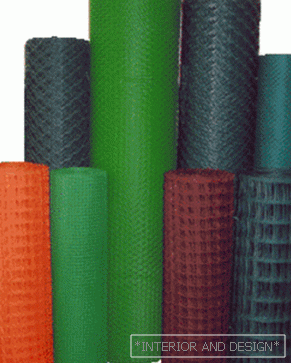 The basis of the grid price is the cost of the wire necessary for its manufacture. The grid is implemented in several ways: just the grid, in the sections of the fence and the fence from the turnkey grid. Usually the price lists indicate the price per m² or per meter, but with a minimum length of the entire fence of at least 70 m. To this is added the cost of the gate and wickets.
The basis of the grid price is the cost of the wire necessary for its manufacture. The grid is implemented in several ways: just the grid, in the sections of the fence and the fence from the turnkey grid. Usually the price lists indicate the price per m² or per meter, but with a minimum length of the entire fence of at least 70 m. To this is added the cost of the gate and wickets.
Mesh fences are the cheapest with any purchase option. From the finished fencing from other materials, the price can vary from three to ten times.
An approximate range of prices for the Rabits can give some idea of the price level of the metal grid. Cheapest mesh can cost 30 руб. for m², and the most expensive is more than 500 rubles. per m². The minimum price when installing a turnkey fence, taking into account the pillars will already be about 200 rubles. per m².
This suggests that regardless of whether the mesh is bought in a roll, maps or sections, installing it yourself can save a lot.
Do-it-yourself grid installation
For the manufacture of fence mesh tension and section ways
The easiest way to make a fence in a tension method. This requires a chain-link in rolls, pillars (metal, wood, reinforced concrete or asbestos cement) and wire.
Necessary materials
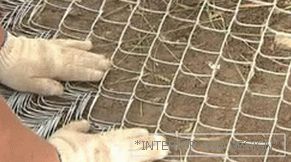 To determine the need for the grid, it is necessary to stretch a cable along the perimeter of the section and measure its length. Thus, the length of the grid is defined. The number of pillars is calculated from the calculation one pillar on 2.5 m plus extra wicket and gate. The height of the fence, and accordingly the height of the pillars is selected depending on the need, taking into account the multiplicity of two feet. Mesh material is desirable to acquire the most resistant to corrosion, but this decision largely depends on the available finances.
To determine the need for the grid, it is necessary to stretch a cable along the perimeter of the section and measure its length. Thus, the length of the grid is defined. The number of pillars is calculated from the calculation one pillar on 2.5 m plus extra wicket and gate. The height of the fence, and accordingly the height of the pillars is selected depending on the need, taking into account the multiplicity of two feet. Mesh material is desirable to acquire the most resistant to corrosion, but this decision largely depends on the available finances.
The cheapest are wooden poles, but they are the least durable. On the pillars hooks are fixed for the Rabit's overhang. Installed pillars must be above the grid or equal to it. For fences, it is recommended to choose a grid with wire with a thickness of more than 2 mm with a corrosion-resistant coating.
Mesh Mounting
For digging holes for the pillars is better to rent мобобур, then they will be even and the right depth. In the absence of such an opportunity will have to dig holes manually and then ram. Poles should be deepened to 1/3 of the height of the product (this should not be forgotten when buying) Sand and gravel or slag are laid on the bottom and compacted. After installation, the poles fall asleep a mixture of sand and rubble, а грунт снова тщательно утрамбовывается. При использовании мобобура эти операции значительно упрощаются. При установке столбов из металла их основания бетонируют.
The chain-link is mounted starting from the corner post. The grid is hung and fastened with staples tied with wire or welded. It is better to hang a grid of black steel 15 cm above the ground, in order to avoid severe corrosion. Anti-corrosion mesh You can vice versa buried in the ground.
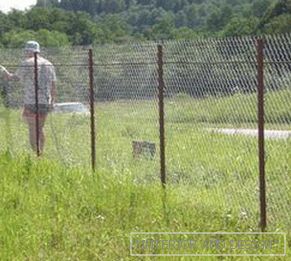 After fixing the mesh to the first pole, the roll is unwound and attached to the next one. The grid must be tightened very hard to ensure the rigidity of the fence. To do this, usually pull through the top and bottom rows of cells wire, которую также крепят к столбам. Далее при окончании рулона сетку можно закрепить внахлёст, а можно из полотна вывинтить крайнюю wire, затем совместить с торцом второго рулона и сшить их путём ввинчивания вынутой проволоки. В результате образуется сплошная сетка.
After fixing the mesh to the first pole, the roll is unwound and attached to the next one. The grid must be tightened very hard to ensure the rigidity of the fence. To do this, usually pull through the top and bottom rows of cells wire, которую также крепят к столбам. Далее при окончании рулона сетку можно закрепить внахлёст, а можно из полотна вывинтить крайнюю wire, затем совместить с торцом второго рулона и сшить их путём ввинчивания вынутой проволоки. В результате образуется сплошная сетка.
Another option is sectional fence. Grid предварительно вваривается в стальную раму. На столбы привариваются или привинчиваются крепления, на которые крепятся рамы. Обычно такие секции приобретаются в определённых стандартных размерах. Расчёт количества столбов осуществляется исходя из них. Установка столбов осуществляется as well as and just for the grid.
Ограждение из сварной сетки также часто используется. Для этого нужна более трудоёмкая процедура монтажа. By всему периметру забора выкапывается траншея. На глубину 1 м и шириной около полуметра. Засыпается основание from sand and rubble. Изготавливается опалубка, возвышающаяся на 20 см от поверхности. В траншее устанавливается арматурный каркас из стального прутка. На стойки привариваются крепления из полосовой стали. Затем заливается бетон и уплотняется. Byверхность бетона выравнивается и в таком виде фундамент оставляют на некоторое время пока раствор не затвердеет. Grid раскраивается в размер и крепится к рамке сваркой. При желании рамку можно дополнительно reinforce corner. By welding or bolting sections are attached to the racks. On this welded fence from the sections on the strip foundation is ready. Just like sections, gates and wickets are fastened.
The device of a net fence does not represent special complexity. Attracts him moderate cost, which is especially important with a large length of the fence. The sectional design makes it possible to create various design solutions and decorate the fence with a large number of additional elements. And the best protection from prying eyes will always be a wall of green plantings, planted along the fence from the inside of the territory.


